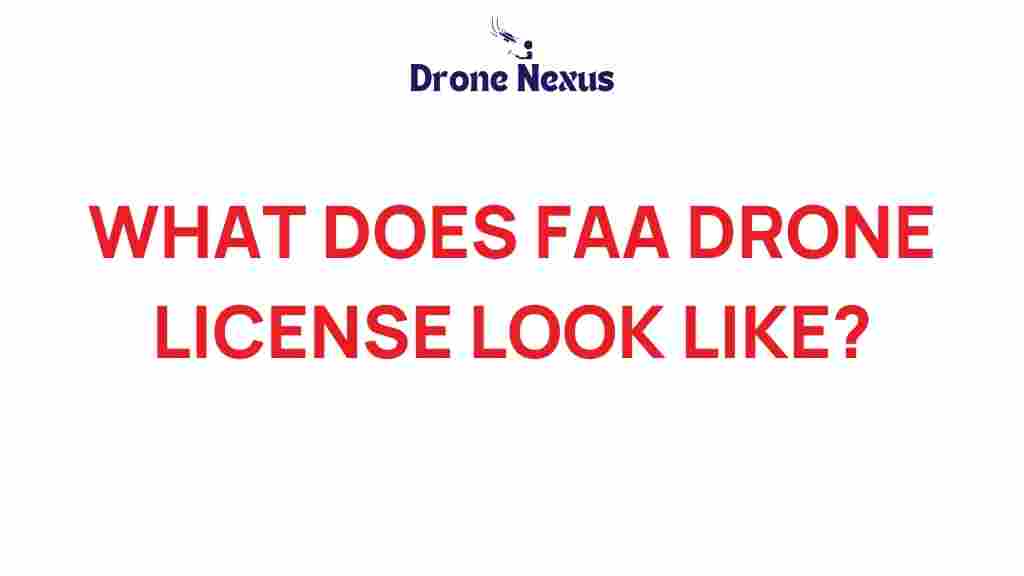What Does a FAA Drone License Look Like?
The Federal Aviation Administration (FAA) drone license is essential for anyone looking to operate drones for commercial purposes in the United States. Understanding what this license entails can help aspiring drone pilots navigate the requirements and preparation needed to obtain one. In this article, we’ll delve into the details of the FAA drone license, including its appearance, application process, and important tips for success.
Understanding the FAA Drone License
The FAA drone license, formally known as the Remote Pilot Certificate, is a credential that allows individuals to legally operate unmanned aerial vehicles (UAVs) for commercial use. Here are the main features of this license:
- Official Certificate: The license is a tangible document that proves the holder has met all necessary FAA requirements.
- Identification: It includes the pilot’s name, date of issuance, and a unique certificate number.
- Regulatory Compliance: The FAA drone license signifies that the pilot has passed the required knowledge test and is familiar with the regulations governing drone operations.
What Does the FAA Drone License Look Like?
The FAA drone license resembles other government-issued identification documents. Here’s what you can expect:
- Size: The license typically measures 2.5 inches by 3.5 inches, similar to a standard credit card.
- Design: The design features the FAA logo, the pilot’s name, certificate number, and validity period.
- Security Features: The license may include holograms or other security measures to prevent forgery.
How to Obtain an FAA Drone License
Acquiring an FAA drone license involves a structured process. Below, we outline the steps you need to take to obtain your Remote Pilot Certificate.
Step 1: Understand the Requirements
Before you start the application process, familiarize yourself with the requirements:
- You must be at least 16 years old.
- You need to be able to read, write, and speak English.
- You must pass the FAA’s Aeronautical Knowledge Test.
- No disqualifying criminal offenses.
Step 2: Prepare for the Knowledge Test
To pass the Aeronautical Knowledge Test, you should study various topics, including:
- Airspace classifications and operating requirements.
- Weather and its impact on drone operations.
- Emergency procedures and drone performance.
- Regulations and the responsibilities of remote pilots.
Consider enrolling in a training course to enhance your understanding. Many online platforms offer FAA drone license prep courses.
Step 3: Schedule and Take the Test
You can schedule your test through an FAA-approved testing center. On the day of the test:
- Arrive early and bring valid identification.
- Be prepared for a computer-based exam.
- After passing, you will receive a temporary certificate.
Step 4: Complete the FAA Form 8710-13
After passing the test, you need to complete the FAA Form 8710-13, which is the application for the Remote Pilot Certificate. This form can be completed online via the FAA’s Integrated Airman Certification and Rating Application (IACRA) system.
Step 5: Submit Background Check
Once your application is submitted, the FAA will conduct a background check. This process can take several weeks, so patience is key.
Step 6: Receive Your FAA Drone License
After your application is approved, you will receive your Remote Pilot Certificate. This document is valid for two years, after which you will need to renew it.
Maintenance and Renewal of Your FAA Drone License
Maintaining your FAA drone license is crucial for continued compliance and safe operations. Here’s what you need to know about renewal:
- Renewal Requirements: You must complete a recurrent training course or retake the knowledge test every two years.
- Keeping Records: Document your flight hours and any training completed to facilitate the renewal process.
Troubleshooting Tips for FAA Drone License Applicants
Obtaining your FAA drone license can sometimes present challenges. Here are some common issues and how to address them:
Problem 1: Difficulty Passing the Knowledge Test
If you’re struggling with the Aeronautical Knowledge Test, consider the following:
- Review study materials and take practice tests.
- Join a study group or seek help from experienced pilots.
- Consider a formal training program for comprehensive instruction.
Problem 2: Delays in Background Check
Background checks can sometimes take longer than expected. Here’s how to handle it:
- Ensure all information on your application is accurate.
- Contact the FAA for updates if you experience significant delays.
- Be patient; the process can take several weeks.
Conclusion
Obtaining an FAA drone license is a critical step for anyone looking to operate drones commercially in the United States. Understanding the appearance and the process of acquiring the FAA drone license can help streamline your journey. Whether you’re a hobbyist aiming to turn your passion into a profession or an established business looking to expand your aerial services, being equipped with the proper certification is essential.
For more information about the FAA drone license and the regulations surrounding drone operations, be sure to visit the official FAA UAS website. If you’re looking for training resources, check out this link for some recommended courses. With the right preparation and knowledge, you can successfully navigate the process and take your drone operations to new heights!
This article is in the category Safety and created by DroneNexus Team
